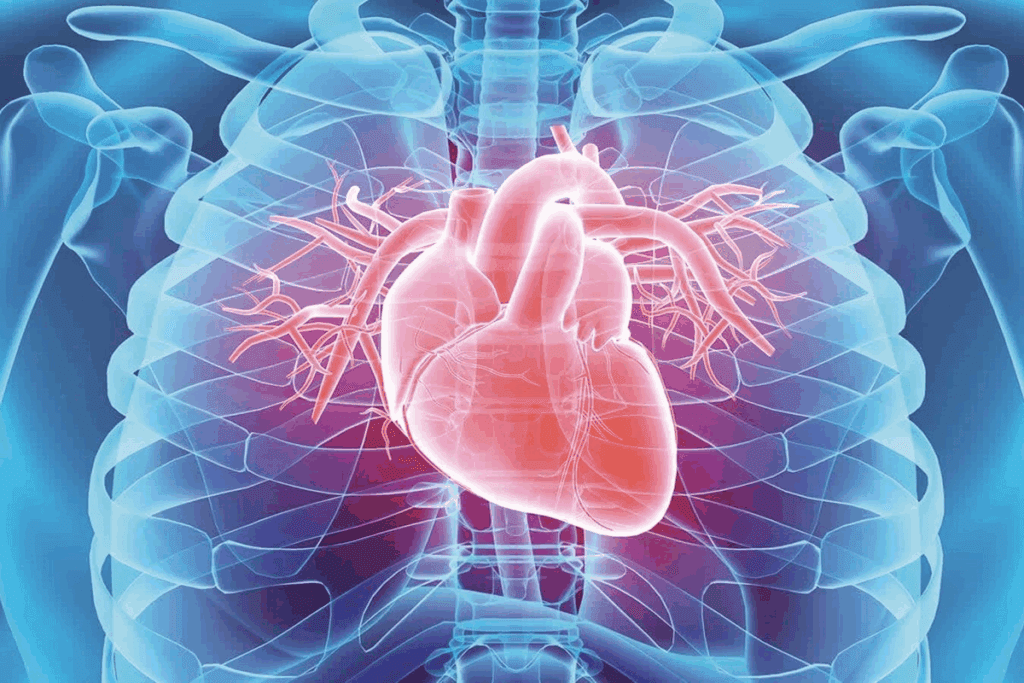Last Updated on November 25, 2025 by Ugurkan Demir

Discover why does congestive heart failure cause water retention and what treatments help manage it.When the heart struggles to pump effectively, it sets off a chain of complex reactions. These reactions lead to fluid retention. At Liv Hospital, we know how congestive heart failure and water retention are connected.
When the heart can’t pump enough blood, the kidneys hold onto sodium and water. This causes fluid buildup.
The relationship between the heart and kidneys is key to understanding heart failure and water retention. By grasping these mechanisms, we can manage heart failure symptoms better. This helps improve patient outcomes.

To understand why congestive heart failure causes water retention, we need to know the basics. This condition happens when the heart can’t pump enough blood for the body’s needs.
Heart failure isn’t a disease but a condition caused by other issues. It’s divided into types based on how well the heart pumps blood. The main types are heart failure with reduced ejection fraction (HFrEF), heart failure with preserved ejection fraction (HFpEF), and heart failure with mid-range ejection fraction (HFmrEF).
Knowing these types helps doctors choose the right treatment for each patient.
A healthy heart pumps blood well by contracting and relaxing in sync. But a failing heart can’t do this efficiently. This can be due to high blood pressure, heart disease, or valve problems.
This struggle leads to fluid buildup in the body.
Heart failure becomes more common with age, affecting about 1-2% of adults in developed countries. Risk factors include high blood pressure, heart disease, diabetes, obesity, and a history of heart attack. Knowing these risks helps in early treatment and management.
Understanding heart failure’s definition, types, and risks helps us see why it causes water retention and fluid buildup.

Fluid balance in the body is kept in check by the kidneys, hormones, and other processes. It’s vital for keeping the body stable and working right.
The body has several ways to manage fluid balance. Sodium and water reabsorption in the kidneys are key. Hormones tell the kidneys how much to reabsorb, based on the body’s needs.
When blood volume drops, the body works to keep more sodium and water. This helps bring blood volume back up.
The kidneys are essential for fluid balance. They control water and electrolytes by adjusting urine production. When we’re dehydrated, they make more concentrated urine to save water.
When there’s too much fluid, they make more urine to get rid of it. They also keep electrolyte levels balanced, which is important for nerves and muscles.
Hormones like aldosterone and vasopressin (also known as ADH) are vital for water balance. Aldosterone helps the kidneys reabsorb sodium, which affects water reabsorption. Vasopressin makes the kidneys reabsorb more water, concentrating urine and saving body water.
It’s important to have the right balance of these hormones. Imbalances can cause too much or too little fluid in the body.
When the heart can’t pump well, it leads to fluid buildup. Congestive heart failure (CHF) means the heart can’t pump enough blood. This causes many changes in the body.
CHF is marked by less blood flow to organs, including the kidneys. This sets off a chain of responses to keep blood pressure up. “The body’s response to decreased cardiac output is a complex interplay of neural and hormonal mechanisms,” says a leading cardiologist.
As the heart pumps less, the body tries to keep blood pressure stable. It does this by tightening blood vessels and increasing heart rate. But, this also puts more strain on the failing heart.
Neurohormonal activation is key in CHF. The sympathetic nervous system kicks in to help the heart. This leads to more norepinephrine in the blood.
This activation causes blood vessels to constrict, heart rate to increase, and sodium to be retained. The RAAS is also turned on, making more sodium and water retention.
The RAAS plays a big role in CHF. When blood flow is low, the kidneys release renin. This starts a chain that ends with aldosterone.
Aldosterone makes the kidneys hold onto sodium, leading to water retention and more blood volume. While it helps keep blood pressure up, it also worsens heart failure symptoms. As Dr. Smith notes, “The RAAS is a critical target for therapeutic intervention in heart failure.”
Knowing how the RAAS affects fluid retention is key in managing CHF. Medications like ACE inhibitors and ARBs can help reduce fluid buildup.
Fluid retention in heart failure is more than just a symptom. It’s a key part of a cycle that makes heart problems worse. When the heart can’t pump well, it sets off a chain of events leading to fluid buildup.
Heart failure first leads to reduced renal perfusion. This means the kidneys get less blood. This makes it tough for the body to get rid of extra fluids and salts.
So, the kidneys hold onto more sodium and water. This increases blood volume and puts more stress on the heart.
The body tries to cope with less heart function by holding onto salt and water. The renin-angiotensin-aldosterone system (RAAS) kicks in, raising aldosterone levels. Aldosterone helps keep sodium in the body.
This complex process leads to too much fluid, making the heart work even harder. It’s a tough cycle to break.
Fluid buildup makes the heart work harder, making it pump less effectively. This decline in heart function keeps the cycle of fluid retention and heart failure going.
It’s key to understand this cycle to find ways to manage it. We need strategies that not only ease symptoms but also tackle the root causes. This can lead to better outcomes for patients.
The pathophysiology of congestive heart failure involves complex hormonal changes. These changes lead to fluid retention. It’s key to understand these imbalances for effective treatment.
Vasopressin, or antidiuretic hormone (ADH), is vital for water balance. In heart failure, its levels rise. This causes the kidneys to hold more water, leading to fluid retention.
Elevated vasopressin levels can lead to:
Natriuretic peptides, like B-type natriuretic peptide (BNP), are heart hormones. They help counteract vasopressin and other vasoconstrictors.
| Hormone | Function | Effect in Heart Failure |
| Vasopressin (ADH) | Regulates water balance | Increased water reabsorption |
| Natriuretic Peptides (BNP) | Promotes vasodilation and natriuresis | Counteracts vasoconstriction and fluid retention |
The sympathetic nervous system kicks in when the heart’s output drops. It increases heart rate and narrows blood vessels. This also leads to more sodium and water retention in the kidneys, worsening fluid overload.
It’s vital to grasp how these hormonal systems interact to manage fluid retention in the heart. By focusing on these imbalances, doctors can create better treatment plans for heart failure patients.
Fluid retention in heart failure can cause a range of symptoms. These symptoms can be mild or life-threatening. As heart failure worsens, the body struggles to balance fluids, leading to complications.
Fluid retention often leads to peripheral edema. This is swelling in the legs and feet. It happens because the heart can’t pump blood well, causing fluid to build up.
Peripheral edema can cause discomfort, pain, and make it hard to move. It’s important for patients to watch their condition closely. They should tell their healthcare provider about any changes.
| Characteristics | Peripheral Edema |
| Location | Typically in legs and feet |
| Symptoms | Swelling, discomfort, pain |
| Impact | Reduced mobility, decreased quality of life |
Pulmonary edema is a severe form of fluid retention. It happens when fluid builds up in the lungs. This condition is very serious and needs quick medical help.
Symptoms include shortness of breath, coughing, and feeling like you can’t breathe. You might also wheeze and have a fast heart rate.
Prompt treatment is key to managing pulmonary edema.
Ascites is fluid buildup in the belly. It’s a complication of heart failure. It can cause discomfort, nausea, and trouble breathing.
Managing ascites involves diet changes, medicine, and sometimes draining the fluid. It’s important to watch for signs and tell your healthcare provider.
Knowing about fluid retention in heart failure is key to managing it. Recognizing symptoms early and getting the right care can improve patients’ lives.
Accurate diagnosis and monitoring of fluid retention are key in managing heart failure. We will look at the methods used to diagnose and monitor fluid retention. This helps healthcare providers create effective treatment plans.
Clinical assessment and physical examination are the first steps in diagnosing fluid retention in heart failure patients. We look for signs like peripheral edema, jugular venous distension, and pulmonary congestion. A thorough physical examination helps us understand the severity of fluid retention and its impact on the patient’s overall condition.
The clinical assessment involves taking a detailed medical history. This includes symptoms such as shortness of breath, fatigue, and swelling in the legs and feet. We also evaluate the patient’s functional capacity and assess for any signs of cardiac decompensation.
Laboratory tests and biomarkers are vital in diagnosing and monitoring fluid retention in heart failure. We use tests like serum electrolytes, blood urea nitrogen (BUN), and creatinine to assess renal function and identify any electrolyte imbalances.
B-type natriuretic peptide (BNP) and N-terminal pro-b-type natriuretic peptide (NT-proBNP) are biomarkers that help diagnose heart failure and monitor fluid retention. Elevated levels of these biomarkers indicate increased ventricular wall stress and fluid overload.
| Laboratory Test | Purpose | Interpretation |
| Serum Electrolytes | Assess electrolyte balance | Abnormal levels may indicate imbalance |
| BUN and Creatinine | Evaluate renal function | Elevated levels may indicate renal impairment |
| BNP/NT-proBNP | Diagnose heart failure and monitor fluid retention | Elevated levels indicate fluid overload |
Imaging studies are essential for detecting fluid retention in heart failure patients. We use chest X-rays to assess for pulmonary congestion and cardiomegaly. Echocardiography helps evaluate cardiac function and identify any causes of fluid retention.
Other imaging modalities, such as cardiac MRI or CT scans, may be used to assess cardiac structure and function in more detail. These tests help us identify any underlying conditions contributing to fluid retention.
Home monitoring strategies empower patients to track their condition and seek timely medical intervention. We educate patients on monitoring their weight, blood pressure, and symptoms. This enables them to identify early signs of fluid retention.
Patients are advised to weigh themselves daily and report any significant weight gain to their healthcare provider. Monitoring blood pressure and symptoms such as shortness of breath and fatigue also helps identify fluid retention.
By combining clinical assessment, laboratory tests, imaging studies, and home monitoring strategies, we can effectively diagnose and monitor fluid retention in heart failure patients. This improves their overall management and quality of life.
Managing heart failure and water retention requires both medicine and lifestyle changes. We’ll look at how these strategies help ease symptoms and better patient outcomes.
Diuretics are key in handling fluid buildup in heart failure. They help get rid of extra fluid, easing symptoms like swelling and breathing trouble.
There are different diuretics, like loop, thiazide, and potassium-sparing types. Loop diuretics, like furosemide, are often used because they work well.
| Type of Diuretic | Mechanism of Action | Examples |
| Loop Diuretics | Inhibit sodium and chloride reabsorption in the loop of Henle | Furosemide, Bumetanide |
| Thiazide Diuretics | Act on the distal convoluted tubule to reduce sodium reabsorption | Hydrochlorothiazide, Chlorthalidone |
| Potassium-Sparing Diuretics | Reduce potassium excretion by acting on the collecting duct | Spironolactone, Amiloride |
ACE inhibitors and ARBs are vital in heart failure care. They adjust the RAAS system, reducing blood vessel constriction and sodium hold. This boosts heart function.
SGLT2 inhibitors, first for diabetes, also help heart failure. They cut down hospital stays and improve heart health.
Changing what we eat is key in managing heart failure and water retention. Eating less sodium helps with fluid buildup. A balanced diet supports heart health.
Adding regular exercise, quitting smoking, and drinking less alcohol also help. These lifestyle changes improve heart failure care.
By using these treatments together, we can greatly improve life for those with heart failure and water retention.
Managing fluid retention is key for heart failure patients to live better lives. Fluid buildup causes discomfort and makes the condition worse. Healthcare providers can improve care and outcomes by understanding and treating fluid retention.
Heart failure management needs a full plan. This includes diuretics, diet changes, and certain medicines like ACE inhibitors. These steps help patients feel better and live better lives.
We stress the need for a complete approach to heart and fluid issues. This way, we can help patients with heart failure live better. With the right care, heart failure patients can have more comfortable lives.
Congestive heart failure happens when the heart can’t pump enough blood. This leads to fluid buildup. The body then holds onto more sodium and water, causing swelling.
When the heart pumps less, it sends less blood to the kidneys. This makes it hard for the kidneys to remove extra fluid. The kidneys then hold onto more sodium and water, causing swelling.
The RAAS helps control fluid balance. In heart failure, it gets activated. This leads to more aldosterone, which makes the body hold onto sodium and water.
Hormonal imbalances play a big role in fluid retention. Changes in vasopressin, the nervous system, and natriuretic peptides affect how the body handles fluid. This makes it hard to manage fluid balance.
Fluid retention shows up in many ways. You might see swelling in your legs and feet, fluid in your lungs, or fluid in your belly. These symptoms come from how the heart works and how the body handles fluid.
Doctors use many ways to find and track fluid retention. They look at your symptoms, do tests, and use imaging. Keeping an eye on your weight and symptoms at home is also important.
Treatment includes using diuretics to get rid of extra fluid. Doctors also use medicines like ACE inhibitors and SGLT2 inhibitors. Changing your diet and lifestyle can also help.
Managing fluid retention can make a big difference. It can help you feel better, go to the hospital less, and live a better life.
Heart problems and fluid retention are connected. When the heart can’t pump well, it leads to fluid buildup. This makes the heart work even harder, creating a cycle.
Heart failure patients retain fluid because their heart can’t pump enough. This leads to sodium and water buildup. The body’s response to this makes it harder to manage fluid.
Fluid overload puts extra strain on the heart. This makes the heart work even harder, leading to worse pumping ability. It makes the condition worse.
Diuretics help by getting rid of extra sodium and water. This reduces fluid overload and helps alleviate symptoms.
Yes, making changes in your diet and lifestyle can help. Reducing sodium, watching your fluid intake, and keeping a healthy weight can manage fluid retention.
Subscribe to our e-newsletter to stay informed about the latest innovations in the world of health and exclusive offers!